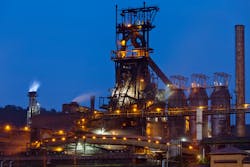Midwestern steel mill improves regulatory compliance with a digital ecosystem that employs IoT and real-time analytics
One of the oldest and largest steel production facilities in the U.S. has implemented an automated solution to monitor ammonia levels in its wastewater, finally enabling the plant to meet limits set by environmental regulatory agencies. Monitoring and mitigating ammonia levels in wastewater is key to the plant’s steel production, with as much as 75,000 gallons / 283,906 liters of water used per ton of steel produced. Until recently, the facility found it challenging to reach acceptable ammonia levels in its discharge water and was failing to meet regulatory standards.
A new strategy at the plant to use cutting-edge digital tools reflects the plant’s efforts to use its water more efficiently and discharge it more responsibly. The plant partnered with Nalco Water, Ecolab’s water management company, to implement Water Quality, a digital service powered by ECOLAB3D, to bring increased visibility, performance and profitability to its water recycling loop. The steel mill’s compliance with environmental regulations hinges on its ability to collect insights into key operational processes and their impacts on water quality within the system.
“We wanted to move this mill from a reactive state to a proactive, automated state, with an end goal of real-time monitoring through Ecolab’s Water Quality, powered by ECOLAB3D,” said Tom Banzen, account manager at Ecolab. “The challenge was capturing critical information that is uniquely relevant to this particular facility, which required building a customized digital solution.”
To give the steel mill real-time monitoring of its wastewater ammonia levels, Nalco Water deployed sensors within the system at both pre- and post-treatment stages to provide data to the ECOLAB3D intelligence platform. This data is then amassed and analyzed in a customized way that is specific to the plant, which provides distinct insights for its unique operations.
“Parameters vary widely from mill to mill, so it’s essential to think outside of the box to tailor our digital solutions for the steel industry,” said Richard LeNeave, a district manager with Ecolab. “It’s exciting to lead the way in accommodating specific industry needs within Water Quality to make it even more valuable to our steel industry partners.”
Real-time results
Water used in steel production facilities circulates in a recycle loop. Over time, it becomes laden with corrosive and scaling elements that ultimately render it unfit for continued cycling, and some of the water (blowdown) is treated and discharged. At the steel mill’s wastewater treatment plant, ammonia and other chemicals in the unusable water are removed through treatment to meet regulatory outfall limits before the water is returned to the receiving waters.
“Violations of federal standards can result in daily and monthly fines that climb into the tens of thousands of dollars. In addition to the fines, traditional monitoring methods that take several days to deliver results increase the risk of significant environmental harm and inflict reputational damages to companies,” Banzen explained.
Water Quality now provides the steel mill instantaneous performance monitoring updates by combining information from the plant’s custom sensors, controller data, field data and laboratory results. The steel mill views these results through an ECOLAB3D digital dashboard that analyzes the data in various ways, giving the plant several ways to visualize its operations and generate actionable insights. This enables the plant to respond with predictive or corrective steps to bring operations under control, such as implementing chemistry changes or making other adjustments.
With Water Quality in place, the steel mill has been able to remain under the daily ammonia outfall limit of 1,000 lbs / 454 kg and the monthly average of 425 lbs / 193 kg discharged for the last 2.5 years. Early in the process, Nalco Water’s chemical and mechanical solutions, such as running the system at a higher pH and incorporating fountains and spargers to help liberate additional ammonia out of the water, helped the plant avoid violations. Over time, the incorporation of ammonia analyzers and automated controls enabled the steel mill to react in real time to control blowdown and chemistry, further increasing the plant’s success.
As environmental, social and corporate governance factors continue to drive influence across all industries, Banzen said Ecolab’s solution helps facilities reduce their water footprint.
“Giving a steel mill the ability to understand how its processes are affecting ammonia discharge levels in real time is a true game changer, especially for long-term sustainability impact.”
For more information, visit www.ecolab.com.
Chel Lancaster is a communications manager at Nalco Water where she is passionate about using the power of words to make a positive impact on customers’ operations, communities, and the world. Her professional work with words includes the realms of science and technology, healthcare, social services, and higher education. Lancaster is based out of Nalco Water headquarters in Naperville, Illinois.
About the Author

Chel Lancaster
Communications Manager, Global Power and Primary Metals Industries
Chel Lancaster is a communications manager at Nalco Water where she is passionate about using the power of words to make a positive impact on customers’ operations, communities, and the world. Her professional work with words includes the realms of science and technology, healthcare, social services, and higher education. Lancaster is based out of Nalco Water headquarters in Naperville, Illinois.
